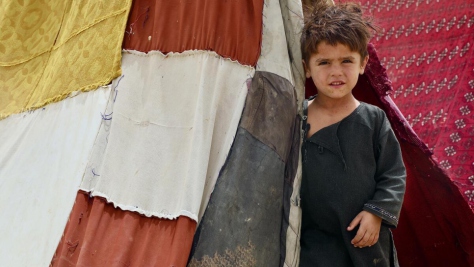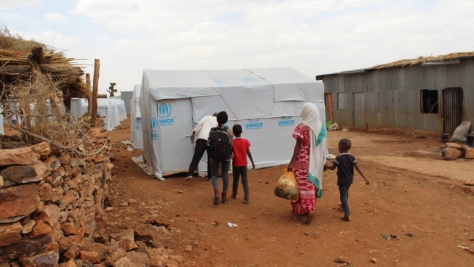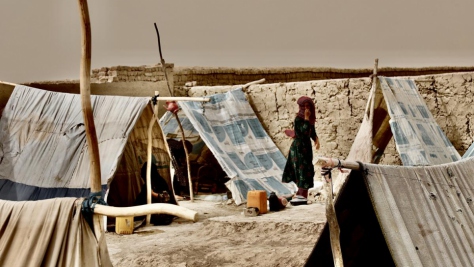Ethiopia: Somali refugees to be relocated away from border
This is a summary of what was said by UNHCR spokesperson Jennifer Pagonis – to whom quoted text may be attributed – at today's press briefing at the Palais des Nations in Geneva.
In Ethiopia today (Friday), UNHCR teams are expected to start relocating a group of 500 newly-recognized Somali refugees who fled from renewed conflict in strife-torn south and central Somalia over the last year. They have been staying around the Kebribeyah area, near the Somali border in eastern Ethiopia and are being relocated to a re-opened UNHCR camp at Teferi Ber.
The refugees are part of a group of 4,000 Somali refugees who have recently been granted refugee status by UNHCR and the government's Authority for Refugees and Returnees Affairs (ARRA). An estimated 7,000 additional Somalis who also claim to have fled fighting and insecurity in Somalia, are waiting to be screened at other sites in eastern Ethiopia.
The new camp site at Teferi Ber, some 120 km north of Kebribeyah, was formerly a UNHCR camp which in the 1990s hosted some 49,000 mainly Somalis refugees who had fled fighting in their country. The camp was officially closed in 2001 after all the refugees returned, mainly to the self -declared republic of Somaliland.
After arriving at Teferi Ber, the refugees will spend three days in a reception centre where they will be allocated plots of land to construct homes and given building materials. They will also be given food as well as tarpaulins, blankets, sleeping mats, kitchen sets, jerry cans, kerosene stoves, and soap. The ARRA has established a temporary health centre until permanent structures can be built.
The Somali Region of Ethiopia already hosts more than 16,500 refugees. With the new arrivals, the total is 20,300. At the peak of the Somali refugee crisis in the early 90s, the region hosted 628,000 refugees in eight camps. The overwhelming majority went home between 1997 and 2005, and all of the camps were closed except a camp at Kebribeyah.
Related news and stories
Thousands of newly arrived Somali refugees in Ethiopia relocated to new settlement
Samira's Story
Drought brings life-threatening food shortages for refugees in Ethiopia
100,000 new Somali refugees arrive in Ethiopia in the past month, UN and partners are calling for urgent funding
UNHCR teams and partners rush assistance to some 100,000 newly arrived Somali refugees in hard-to-reach area of Ethiopia
As the Horn of Africa drought enters a sixth failed rainy season, UNHCR calls for urgent assistance
-

News comment: UNHCR latest update on deteriorating situation of Eritrean refugees in Tigray
15 Jul 2021 This news comment is attributable to Ann Encontre, UNHCR Representative in Ethiopia -

Displaced Afghan family struggles to cope amid latest violence
15 Jul 2021 A widowed mother-of-four struggling to take care of her family in a camp is among the 270,000 Afghans displaced since the start of the year by the latest upsurge in fighting. -

The High Commissioner's Championship in review
13 Jul 2021 -

PowerPoint Presentation
13 Jul 2021 -

Statement by UN High Commissioner for Refugees Filippo Grandi on the situation of Eritrean refugees in Ethiopia's Tigray Region
13 Jul 2021 -

IASC Promising Practices Organizational Culture
13 Jul 2021 -

UNHCR warns of imminent humanitarian crisis in Afghanistan
13 Jul 2021 -

Working with Persons with Disabilities in Forced Displacement Facilitator's Guide
12 Jul 2021 The Division of International Protection (DIP) together with the Global Learning and Development Centre (GLDC) developed the Working with Persons with Disabilities in Forced Displacement Facilitator's Guide. The Guide is composed of four modules which can be used separately or jointly in strengthening capacity of UNHCR staff and partners on work with persons with disabilities in forced displacement settings. Topics include understanding disability, disability and forced displacement, and key strategies to foster inclusion. -

Expelled asylum seekers 'crying out for help' in northern Mexico
12 Jul 2021 Removed from the United States, asylum-seekers fear for their safety in northern Mexico and deadly violence if they return to their Central American homelands.
